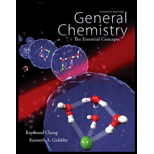
(a)
Interpretation:
The equilibrium constant and Gibb’s free energy for the following cell reaction has to be calculated.
Concept introduction:
Standard reduction potential: The voltage associated with a reduction reaction at an electrode when all solutes are 1M and all gases are at 1 atm. The hydrogen electrode is called the standard hydrogen electrode (SHE).
Standard emf: Eocell is composed of a contribution from the anode and a contribution from the cathode is given by,
Where both
The change in free-energy represents the maximum amount of useful work that can be obtained in a reaction:
Relation between
Relation between
(a)
Explanation of Solution
The given reaction is,
Lead ion is reduced and Magnesium is oxidized; hence oxidation occurs at anode electrode and reduction occurs at cathode electrode.
Calculation of Standard emf:
The standard reduction potential of Mg (+2) as follows,
The standard reduction potential of Pb (+2) as follows,
Calculated standard emf for galvanic cell as follows,
Therefore, Standard emf of a galvanic cell is
Equilibrium constant calculation:
Using Gibb’s free energy equation as follows,
Using equation as follows,
Therefore, the equilibrium constant obtained is
(b)
Interpretation:
The equilibrium constant and Gibb’s free energy for the following cell reaction has to be calculated.
Concept introduction:
Standard reduction potential: The voltage associated with a reduction reaction at an electrode when all solutes are 1M and all gases are at 1 atm. The hydrogen electrode is called the standard hydrogen electrode (SHE).
Standard emf: Eocell is composed of a contribution from the anode and a contribution from the cathode is given by,
Where both
Thermodynamics of redox reactions:
The change in free-energy represents the maximum amount of useful work that can be obtained in a reaction:
Relation between
Relation between
(b)
Explanation of Solution
The given reaction is,
Bromium is reduced and Iodide ion is oxidized; hence oxidation occurs at anode electrode and reduction occurs at cathode electrode.
Calculation of Standard emf:
The standard reduction potential of Br (-1) as follows,
The standard reduction potential of Iodide ion as follows,
Calculated standard emf for galvanic cell as follows,
Therefore, Standard emf of a galvanic cell is
Equilibrium constant calculation:
Using Gibb’s free energy equation as follows,
Using equation as follows,
Therefore, the equilibrium constant obtained is
c)
Interpretation:
The equilibrium constant and Gibb’s free energy for the following cell reaction has to be calculated.
Concept introduction:
Standard reduction potential: The voltage associated with a reduction reaction at an electrode when all solutes are 1M and all gases are at 1 atm. The hydrogen electrode is called the standard hydrogen electrode (SHE).
Standard emf: Eocell is composed of a contribution from the anode and a contribution from the cathode is given by,
Where both
Thermodynamics of redox reactions:
The change in free-energy represents the maximum amount of useful work that can be obtained in a reaction:
Relation between
Relation between
c)
Explanation of Solution
The given reaction is,
Oxygen and proton are reduced and Iron ion is oxidized; hence oxidation occurs at anode electrode and reduction occurs at cathode electrode.
Calculation of Standard emf:
The standard reduction potential of Oxygen as follows,
The standard reduction potential of Iron ion as follows,
Calculated standard emf for galvanic cell as follows,
Reversing half-reaction changes the sign of
Therefore, Standard emf of a galvanic cell is
Equilibrium constant calculation:
Using Gibb’s free energy equation as follows,
Using equation as follows,
Therefore, the equilibrium constant obtained is
d)
Interpretation:
The equilibrium constant and Gibb’s free energy for the following cell reaction has to be calculated.
Concept introduction:
Standard reduction potential: The voltage associated with a reduction reaction at an electrode when all solutes are 1M and all gases are at 1 atm. The hydrogen electrode is called the standard hydrogen electrode (SHE).
Standard emf: Eocell is composed of a contribution from the anode and a contribution from the cathode is given by,
Where both
Thermodynamics of redox reactions:
The change in free-energy represents the maximum amount of useful work that can be obtained in a reaction:
Relation between
Relation between
d)
Explanation of Solution
The given reaction is,
Iodine is reduced and Aluminum is oxidized; hence oxidation occurs at anode electrode and reduction occurs at cathode electrode.
Calculation of Standard emf:
The standard reduction potential of Al (+3) as follows,
The standard reduction potential of Iodide ion as follows,
Calculated standard emf for galvanic cell as follows,
Reversing oxidation half-reaction changes the sign
Therefore, Standard emf of a galvanic cell is
Equilibrium constant calculation:
Using Gibb’s free energy equation as follows,
Using equation as follows,
Therefore, the equilibrium constant obtained is
Want to see more full solutions like this?
Chapter 19 Solutions
Package: General Chemistry with Connect 2-year Access Card
 ChemistryChemistryISBN:9781305957404Author:Steven S. Zumdahl, Susan A. Zumdahl, Donald J. DeCostePublisher:Cengage Learning
ChemistryChemistryISBN:9781305957404Author:Steven S. Zumdahl, Susan A. Zumdahl, Donald J. DeCostePublisher:Cengage Learning ChemistryChemistryISBN:9781259911156Author:Raymond Chang Dr., Jason Overby ProfessorPublisher:McGraw-Hill Education
ChemistryChemistryISBN:9781259911156Author:Raymond Chang Dr., Jason Overby ProfessorPublisher:McGraw-Hill Education Principles of Instrumental AnalysisChemistryISBN:9781305577213Author:Douglas A. Skoog, F. James Holler, Stanley R. CrouchPublisher:Cengage Learning
Principles of Instrumental AnalysisChemistryISBN:9781305577213Author:Douglas A. Skoog, F. James Holler, Stanley R. CrouchPublisher:Cengage Learning Organic ChemistryChemistryISBN:9780078021558Author:Janice Gorzynski Smith Dr.Publisher:McGraw-Hill Education
Organic ChemistryChemistryISBN:9780078021558Author:Janice Gorzynski Smith Dr.Publisher:McGraw-Hill Education Chemistry: Principles and ReactionsChemistryISBN:9781305079373Author:William L. Masterton, Cecile N. HurleyPublisher:Cengage Learning
Chemistry: Principles and ReactionsChemistryISBN:9781305079373Author:William L. Masterton, Cecile N. HurleyPublisher:Cengage Learning Elementary Principles of Chemical Processes, Bind...ChemistryISBN:9781118431221Author:Richard M. Felder, Ronald W. Rousseau, Lisa G. BullardPublisher:WILEY
Elementary Principles of Chemical Processes, Bind...ChemistryISBN:9781118431221Author:Richard M. Felder, Ronald W. Rousseau, Lisa G. BullardPublisher:WILEY





